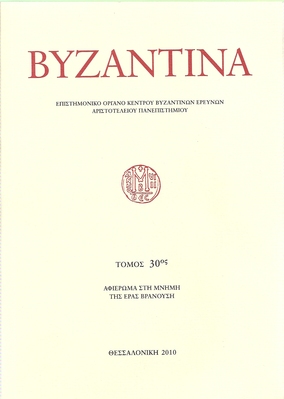Πρώτες παρατηρήσεις για την εξέλιξη των πολιτικών θεσμών της Θεσσαλονίκης στην αυγή του μεσαίωνα : σχόλια στο τέταρτο θαύμα της ανώνυμης συλλογής των θαυμάτων του αγίου Δημητρίου
Part of : Βυζαντινά : επιστημονικόν όργανον Κέντρου Βυζαντινών Ερευνών Φιλοσοφικής Σχολής Αριστοτελείου Πανεπιστημίου ; Vol.26, No.1, 2006, pages 33-61
Issue:
Pages:
33-62
Parallel Title:
Fourth miracle of the second collection of miracles of st. Demetrius
Author:
Abstract:
The object of this essay is to provide a critical discussion of the fourth Miracle of the second Collection of Miracles of St. Demetrius. The text is viewed from the aspect of the information it provides regarding the administration of Thessaloniki in the 7th century. The incident narrated took place in Thessaloniki in the years 676-678 A.D., during the reign of the emperor Constantine IV Pogonatus.The study begins with a critical evaluation of the text from a historical point of view. The first Part deals with a general description of the events. The focus is set on the investigation of the civic authorities and their actions.It is generally admitted (2nd Part) that the Roman administrative system was based on the city as a self-governed administrative entity. It has been accepted that this administration system, which viewed the State as a total of tax-paying communities, survived until at least the end of the 6th century A.D. The third Part is devoted to the examination of the administrative institutions of the city and their powers, as they are indicated in the text of the Miracles, especially the Fourth Miracle of the Second Collection. It appears that the powers of the city Council had been curtailed in favour of a body of potentiores, consisting of the most prominent senators along with some powerful decurions. Evidently this body survived until lately in the 19th century.Aspects of the function of the city administrative organs are discussed in the fourth Part. In this context, it is proposed that the Slavic tribe of Ryncheni lived along the lower course of the river Galico, instead of between the lake Bolbe and the golf of Orfano. The nature of the relations between the city of Thessaloniki and the Slavic tribes around it is also examined. It is proposed that the tribal chief Perboundos stayed in Thessaloniki as a guarantor of friendly relations between the two parts.The development of the administrative system of Thessaloniki is summed up in the Conclusions. The information provided by the accounts of the Miracles is set against the general picture of the internal administration of the Empire in the beginning of the middle Ages. The weaknesses of the Late Roman administrative system are recognized in the account of the fourth Miracle; therefore, the changes which occurred later on with the introduction of the thematic administration units are fully justified.
Subject (LC):
Notes:
Περιέχει ένα χάρτη




